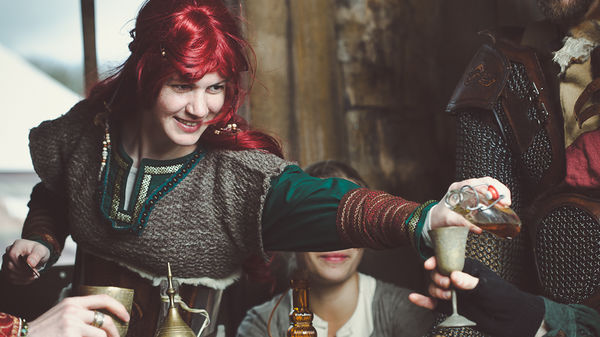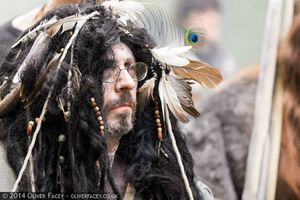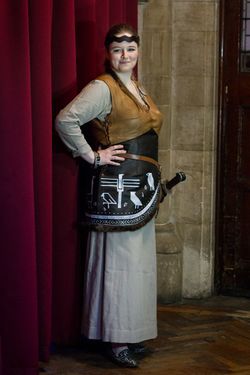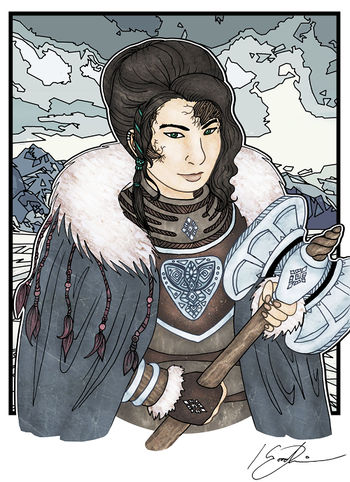Wintermark culture and customs
m (→Scops) |
(→Scops) |
||
| Line 24: | Line 24: | ||
{{Anchor|Art and history}} | {{Anchor|Art and history}} | ||
==Scops== | ==Scops== | ||
Scops are professional entertainers, often travellers, moving from hall to hall performing and looking for new material. Some Scops master an instrument, but many are poets. Some | Scops are professional entertainers, often travellers, moving from hall to hall performing and looking for new material. Some Scops master an instrument, but many are poets. Some strive to master the high art of the Scop, the traditional Wintermark alliterative verse. Suaq and Steinr Scops traditionally give formal recitations of epic tales, favouring the stories of popular heroes. In contrast, Kallavesi Scops often prefer to work with a small audience, telling symbolic stories with complex imagery that are adapted to reflect their audience's situation; the best are designed to help their listeners make auspicious decisions. | ||
In Wintermark, history exists primarily in oral form, and some scops strive to master epic tales of heroic deeds or historical poems for formal situations, while others prefer short and entertaining poems, often improvised, for informal situations such as a tavern. Scops are expected not to just to preserve history, but to denote it's passing. Scops have an important responsibility in Wintermark, for they are the ones who grant people their names. The scops watch the younger heroes of Wintermark, those who have still to make a name for themselves. Once an individual has performed a deed of note, they give them a name, to replace their childhood name. | In Wintermark, history exists primarily in oral form, and some scops strive to master epic tales of heroic deeds or historical poems for formal situations, while others prefer short and entertaining poems, often improvised, for informal situations such as a tavern. Scops are expected not to just to preserve history, but to denote it's passing. Scops have an important responsibility in Wintermark, for they are the ones who grant people their names. The scops watch the younger heroes of Wintermark, those who have still to make a name for themselves. Once an individual has performed a deed of note, they give them a name, to replace their childhood name. | ||
Revision as of 14:37, 26 February 2021
Skein
The Winterfolk believe that each individual has a skein, a path down which that individual travels. A person's skein is not predestined at birth, rather it is fixed in places by the significant choices they make as they pass through life. The steps along the way are only the consequences of your skein; the critical moments are the points at which the individual makes a momentous choice - this is when their skein can alter. In the Winterfolk view, what happens in your life, your skein, is a direct consequence of the choices you make, the path you choose through life - the key therefore is to make the right choices.
Obviously not all the choices that a person makes are notable; what is important are the key points when far-reaching decisions are needed. At such points an individual's skein forks with the opportunity for different consequences. The Kallavesi have handed down various methods to help them identify these moments and more importantly to be able to identify what the consequences might be. Those who can accurately read a person's skein and give them advice to help them make the most auspicious choices, called mystics, are important figures in Winterfolk society.
According to the mystics, once the skein has been forked then it cannot be reversed. A person's skein can only be travelled one way; decisions cannot be undone, so it is foolish to dwell on any decision once the choice has been made. By accepting that your skein is fixed, you can commit yourself to your course and make the best of what has been decided. By travelling forwards along your skein you can hope that the future will bring opportunities to make more auspicious choices.
Scars
Scars are important to the Winterfolk. According to tradition a warrior who emerges blooded from a battle has demonstrated heroism by finding a worthy enemy to fight, and is celebrated as a consequence. As a sign of recognition, some Thanes will cut a young warrior who has fought well in their first battle but not been blooded. Others will mark a young warrior before their first battle as a way to encourage them to avoid taking unnecessary risks. Some bands re-open old wounds before a battle begins so that those who face them can mark their courage. All such cuts are little more than a nick, but done with a sharp knife so that they bleed profusely.
When a warrior is wounded in a memorable fight, they will often encourage the grimnir to treat the wound "so that it scars well." Scars are badges of honour; they serve as a visible mark of the warrior's skill and permit them to boast about the battle later - there is rarely anything to brag about a fight in which you didn't get a scar.
Hospitality
Any traveller visiting a hall in Wintermark may claim one drink, one plate of hot food and a bed by a hearth for one night, without any payment or even thanks. This generosity is mandated for one occasion only; beyond this a hall owes a traveller nothing and may turn them out into the night. However, a guest who works for their sustenance and shelter is entitled to hospitality for another night, and it is customarily unacceptable to refuse a traveller who offers to work. Wintermark folktales are filled with stories of unwanted guests who overstay their welcome which usually end when a cunning Suaq tricks them into taking unmerited food or drink, or into failing to complete their assigned work.
Some thanes choose to follow this tradition when camped with their people in the field, others refuse as tradition only demands they offer hospitality when in their hall.
Birds and feathers
Birds are sacred to the Winterfolk, who believe that they bring a child’s soul at the moment of their birth and carry it away at the moment of death. Some wealthy Winterfolk keep birds of prey, to ensure that the heaviest and most powerful souls are brought to their children when they are born. Birds favour souls of their own nature, so a raptor usually carries the soul of a warrior or great hunter, while an owl or a raven usually brings the soul of a wise mystic or a cunning scout to be reborn.
A bird’s wisdom is contained in the feathers that allow it to fly, and birds discard a feather when they are done with an idea or thought. Winterfolk of a particularly spiritual bent, especially stormcrows and Kallavesi mystics, often collect feathers and wear them for a lunar month. They seek to gain mystical insight by absorbing the discarded thoughts of the bird that shed the feather. Killing an animal specifically to collect its feathers is said to bring bad luck.
Birds are often used as symbols of the virtues in Wintermark. The raven symbolises Wisdom, the goose and the jay both symbolise Vigilance, the eagle, heron and swan all symbolise Pride, jackdaws often symbolise Courage, magpies symbolise Prosperity, hawks and falcons symbolise Loyalty, and the rook symbolises Ambition.
Scops
Scops are professional entertainers, often travellers, moving from hall to hall performing and looking for new material. Some Scops master an instrument, but many are poets. Some strive to master the high art of the Scop, the traditional Wintermark alliterative verse. Suaq and Steinr Scops traditionally give formal recitations of epic tales, favouring the stories of popular heroes. In contrast, Kallavesi Scops often prefer to work with a small audience, telling symbolic stories with complex imagery that are adapted to reflect their audience's situation; the best are designed to help their listeners make auspicious decisions.
In Wintermark, history exists primarily in oral form, and some scops strive to master epic tales of heroic deeds or historical poems for formal situations, while others prefer short and entertaining poems, often improvised, for informal situations such as a tavern. Scops are expected not to just to preserve history, but to denote it's passing. Scops have an important responsibility in Wintermark, for they are the ones who grant people their names. The scops watch the younger heroes of Wintermark, those who have still to make a name for themselves. Once an individual has performed a deed of note, they give them a name, to replace their childhood name.
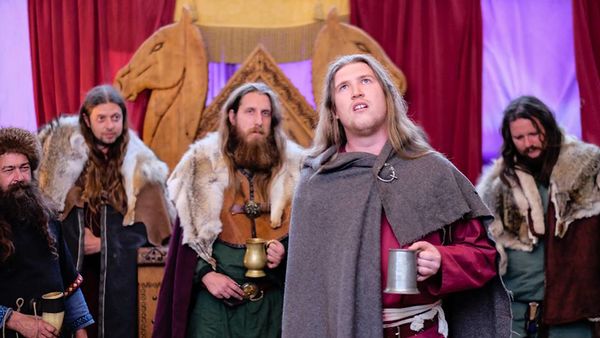
Riddles are also a national pastime. Cold winter nights are both long and tedious, and it is all too easy to fall asleep on duty or lapse into a numbed state of depression. Thinking up and answering clever riddles helps keep the mind limber.
The Winterfolk celebrate and remember the past, but they are never bound by it. This attitude to the past is the foundation of the Wintermark legal system where each transgression is judged on its own merits, rather than on the basis of past precedent. This practical attitude to legality helped to form the basis of the Imperial codes of law.
The good death
The land of Wintermark is harsh but this serves to make the Winterfolk strong. It is the cold forge in which each of them is tempered. They face life unbowed by the ferocity of their land and refuse to acknowledge their own mortality. For this reason, death in their prime while striving to meet a challenge is preferable for many. Warriors seek the good death on the battlefield, but the good death is any ending that comes while pushing yourself to achieve one final act of heroism.
A few choose to walk north into the Heart of Ice, the great ice-storm Sydanjaa, and are never seen again. Legend says that they battle forever against the creatures deep in the storm. When someone chooses to walk into Sydanjaa they do not imagine it will achieve anything, but that it is preferable to a slow decline leading to weakness of mind and body in dotage. There is a widespread acceptance of the idea that those who challenge Sydanjaa find the good death in an attempt to unravel the mysteries and riddles of the endless storm.
Funerals
Heroes are interred in the Kallavesa marshes, their bones lying in the dark waters alongside those of the first king of Wintermark and the great heroes who have come since. As a hero's life fed the nation when they were alive, their body feeds the marsh in death. “To sleep in Kallavesa” is a powerful metaphor for the rewards of heroism, and to speak of “those who sleep in Kallavesa” is to invoke the very heart of what it means to live in Wintermark.
Wealthy Thanes usually pay for a beautifully crafted wooden boat for their body which is then sunk beneath the waters. Paupers make do with a reed raft. Kallavesi mystics are skilled at preserving bodies for the long journey to Kallavesa.
In the past there has been conflict between the funereal mystics and the priests of the Necropolis in Highguard. The Highborn have strong traditions regarding the funerals of heroes and especially Emperors. Several times they have tried to claim that the remains of Winterfolk heroes who have done some great service for the Empire should be honoured by being interred in their cold marble crypts rather than lying in the swamp alongside their ancestors.
Icons and Artistry
Crafting is second nature to the Winterfolk. Stone, metal and wood are carved with runes, but they are rarely painted, coloured or enamelled, as crafters prefer to show the beauty in the underlying colours of the materials. By contrast fabric and leather are often decorated with carefully painted or embroidered images that complement their colour and texture.
A popular symbol of the nation of Wintermark takes the form of the Three Tears, usually white on a red or blue background, and references the gems set into the Crown of Three Tears. Another iconic representation that specifically speak to the unity of the three people are the Three Rings - a trio of interlocking rings woven together. Either of these icons is likely to be decorated with additional runes but precisely which runes varies from artist to artist.
On the battlefield, and as decoration in their halls, Winterfolk prefer brightly colourful banners with simple, clear symbols that can be seen well from a distance. A banner is a glorious shout or a challenge to the enemies of the Winterfolk, rather than a logistical aid to coordinate troop movements. Those who take the battlefield without a banner are sometimes treated with suspicion, due to the implication that they might wish to leave the battlefield without being seen - or plan to do something during the battle without being identified.
Unsurprisingly, a great deal of Wintermark art involves birds, or images of animals with particular symbolic meanings. Wood and stone carving are both popular mediums with Wintermark artists, and while painting is now much more popular than it was it falls behind more durable forms of art. A significant portion of Wintermark painters are from the Steinr tradition, who on the whole embrace the beauty and skill involved in this new artform more readily than their Suaq and Kallavesi cousins. It's common for Wintermark painters to focus more on depictions of the landscape than individuals; the sweeping tundra of Sermersuaq, the grandeur of the mountains and forests of Hahnmark and Skarsind, or the mournful marshes of Kallavesi are much more popular as a subject than individual portraits. Even when a portrait is painting it is likely to set the figure against some powerful feature of the landscape. This is particularly true historically - there are very few depictions of historical Winterfolk figures.
Stringed instruments such as harps or lyres are traditional in Wintermark, especially those that are played while the user sings or recites poetry. Purely instrumental music is uncommon, and much less popular than music and voice in tandem. Usually only cheap or simple instruments are rune-marked, with traditional runic marks being kept for covers and bags in which the instruments are stored. Some claim that this is is because the magic of the runes subtly interferes with the magic of the instrument. See Wintermark Music.
Further Reading
Core Brief
Further Reading
